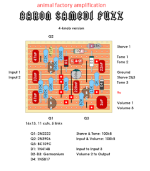Looking at some layouts, I'm seeing some low uf values represented as non-electrolytic caps (1 uf in a specific case). It's clear they intend for a non-polarized cap to be used there.
-Can I use an electrolytic cap there with no ill effects if I orient it the correct way? It's all I have on hand in that value.
-If not, would an MLCC be ok or should I stick get a box cap/greenie? I realize a higher MLCC wouldn't be C0G, which seems to be preferable for those. It looks like I might have space for either one in this particular layout fwiw.
I was just going to grab an assortment like this to fill a couple low-uf gaps- bad idea? https://www.amazon.com/gp/product/B0C1V8Q93P/ref=ox_sc_act_title_3?smid=A3FX7C4A9P37IQ
This is for a fuzz pedal, and I'm mostly concerned about using anything that might make it even noisier than it needs to be! Maybe this doesn't matter much...
-Can I use an electrolytic cap there with no ill effects if I orient it the correct way? It's all I have on hand in that value.
-If not, would an MLCC be ok or should I stick get a box cap/greenie? I realize a higher MLCC wouldn't be C0G, which seems to be preferable for those. It looks like I might have space for either one in this particular layout fwiw.
I was just going to grab an assortment like this to fill a couple low-uf gaps- bad idea? https://www.amazon.com/gp/product/B0C1V8Q93P/ref=ox_sc_act_title_3?smid=A3FX7C4A9P37IQ
This is for a fuzz pedal, and I'm mostly concerned about using anything that might make it even noisier than it needs to be! Maybe this doesn't matter much...







